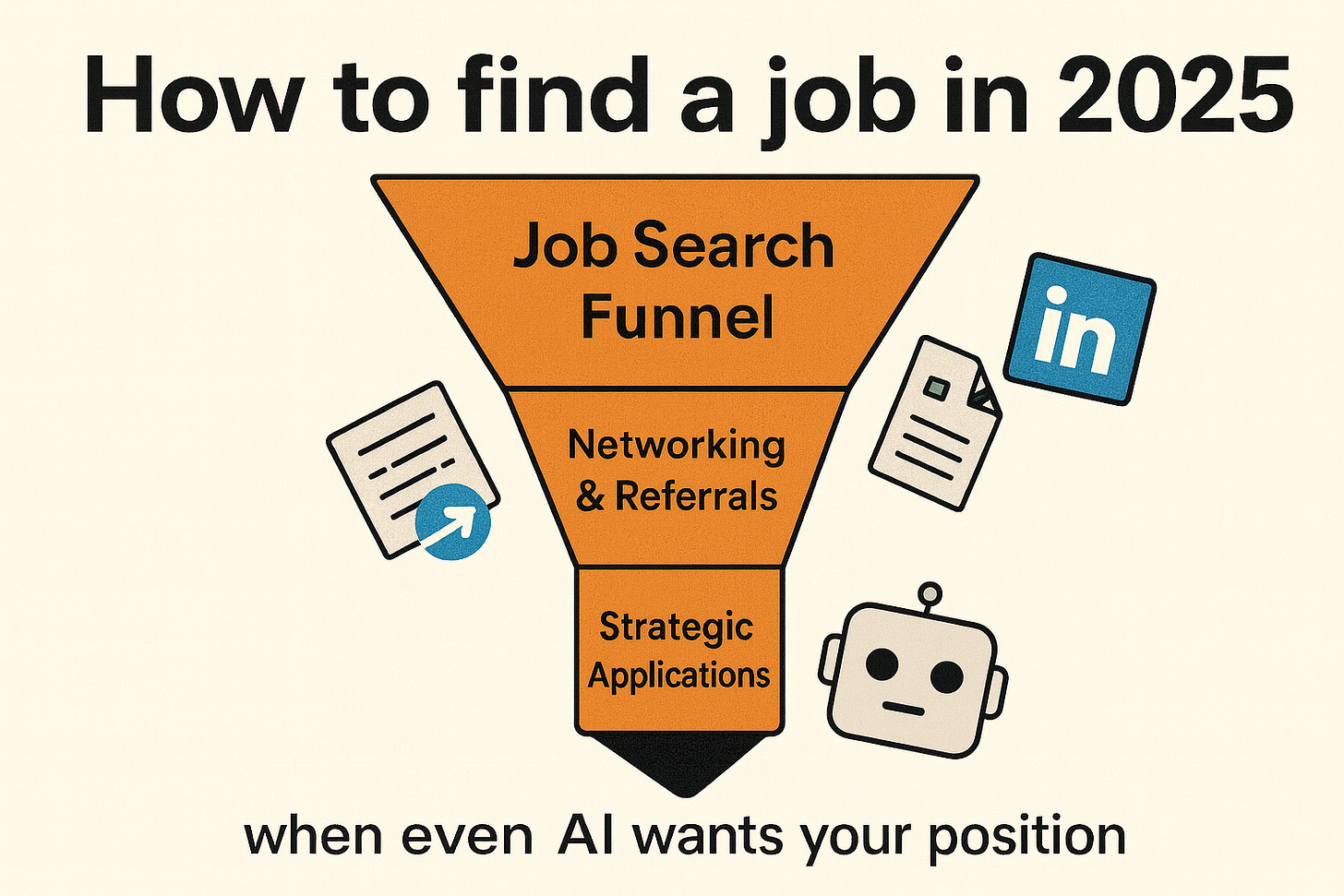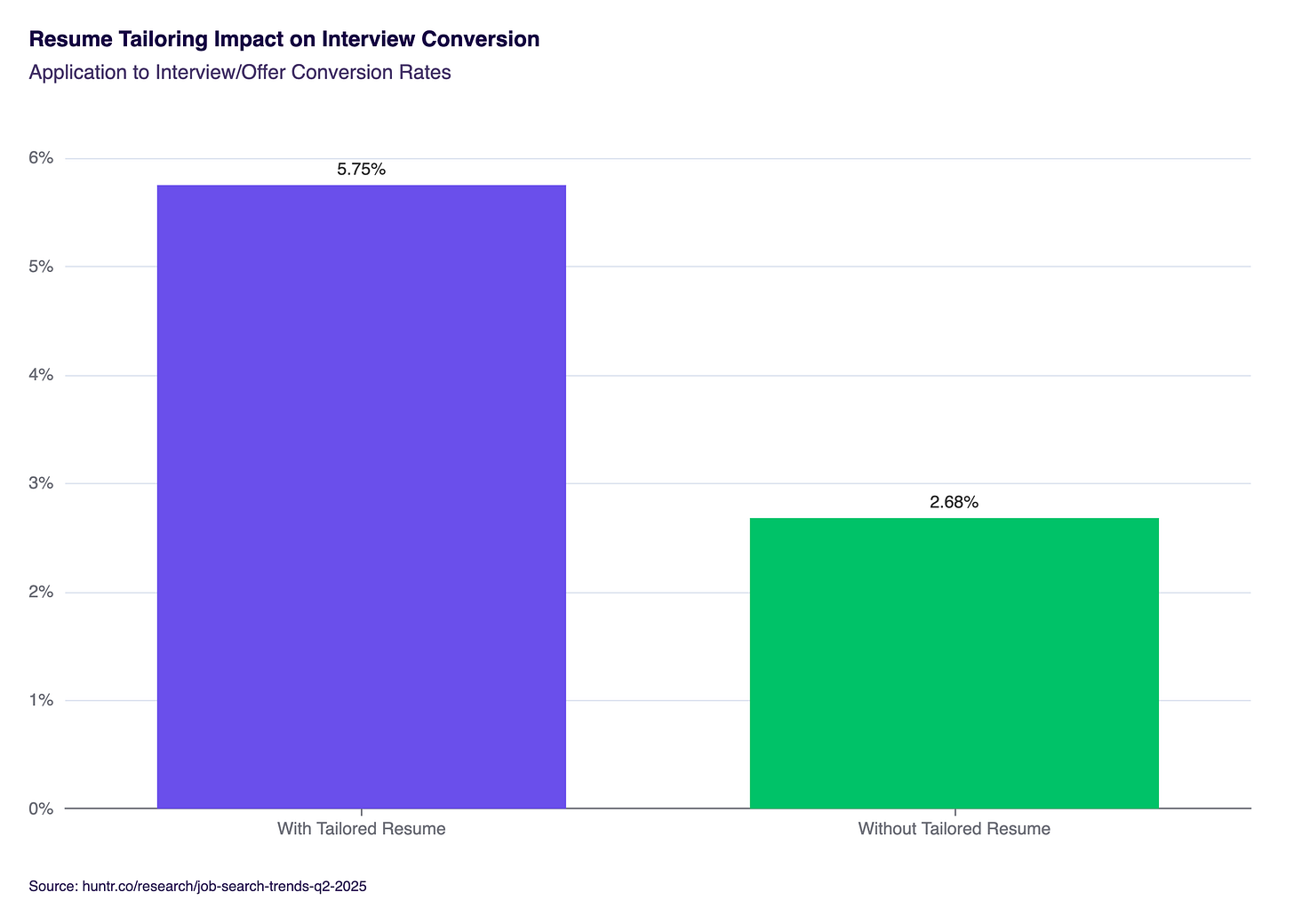3 steps to get hired in big tech in 2025?
About importance of networking, Linkedin, and strategic job hunting
Not so long ago, I joined a big (enough) company. Since then, I’ve developed a mental model for how to approach job searching in 2025, and I want to share it with you today.
Scope:
Role level: mid-senior
Company stage: scale-ups -> mature
Type: tech / product companies
TL;DR
My biggest bet is on networking and referrals. Go get your referrals.
But if you’re good for now - keep reading this article.
I break this process down into several steps (and chapters):
Market context
Step 1 - Where do you want to get?
Step 2 - Become discoverable
Step 3 - Apply strategically
Bonus advice! - oooh, you can’t even imagine what it is :)
And you 🫶 dear reader 🫶 have a chance to roast each step in the comments below or on my LinkedIn.
Market Context
This chapter is mostly my opinion and how I see the current market.
If you’re here just for the practical guide - feel free to skip to the next chapter.
If you like some data - while prepping this article, I read a report with lots of interesting stats for Q2 2025. Check it out if you’re into that kind of thing.
Now, my take: companies don’t want to hire. They have to.
And if they had the chance not to, they’d probably take it.
In early 2025, many companies started saying: “First, try automating it with AI before hiring someone.”
Honestly, that’s exactly what I would (and want to) do myself.
I treat my current position as: “It’s kind of sad that this role even exists. I want to automate it and fire myself.” As you can tell, I work in product operations.
And that’s not exactly a great foundation for an easy job search to begin with.
Generally, I do not see the market as favorable for applicants (let’s call it an employer market). There are many reasons for that: companies are not willing to hire, there’s over-employment, and too many candidates are applying for each position.
Companies might say, “We’re actually actively hiring.”
But in reality, many are mostly hiring senior positions. Which is fine for the scope of this article.
However, the problem is perfectly captured by a short dialogue I had with my friend while job hunting:
me: “Yo, every company is looking for a Senior… but I’m just a middle.”
friend: “Well, if they need a Senior and not a middle, then congrats - you’re now a Senior!”
Many juniors apply for middle positions, middles apply for senior ones, and seniors either don’t want to move or move too much.
It creates a lot of noise, making it very difficult to process applications — on top of the already low motivation to spend budget on hiring.
In my opinion, this means the following:
You need to be clear about where you want to go (company, position, domain, etc.)
You need to be discoverable when your skills or knowledge are needed
You need to have a strategy
Step 1 - Where do you want to get?
Before applying, it’s worth deciding what you’re actually targeting.
Scope it using a few dials:
Stage: early / scale-up / enterprise
Size: headcount, markets, ARR
Domain: fintech, e-commerce, hardware, AI, etc.
Operating type: classic business, banking, tech, ops-heavy
Function: analyst, ops, eng, product/project/program
Level: mid / senior
More to your taste
You don’t need laser focus, but you should define a few non-negotiables.
For example: “Fast-growing AI scale-up, product team.”
That might mean relocating, working remotely, or relaxing one of your criteria (maybe not AI, maybe not hyper-growth).
Doing this gives you a realistic shortlist and helps you coordinate your next steps.
Action items:
Define your key criteria. Example: “Fast-growing ride-hailing company located in the Baltics.”
Make a list of the top companies you actually want to apply to.
For me, those were: Bolt, Wise, Lightyear, Twilio, Microsoft (and a few more).
🔥 Hot take 🔥
The classic “Why do you want to join this product/team?” question is pretty useless for junior, mid, and even for seniors.
Let’s be honest:
”In the end of the day, most of us want
a) a place to do meaningful work and
b) a good compensation.Ideally, I’d be some CEO in some OpenAI/Google/[insert cool company here], “making the world a better place”, but I’m not there yet. So here you are, looking at my CV”😄
Truth is, I don’t have a 5-year plan where I want to be. So, I fail this recruiter’s question.
Therefore I started to approach it from a perspective of what I enjoy doing or maybe even good at: automating things, building systems, generating ideas, and generally working on stuff that excites me.
That’s how I would approach any new job search - and hope it would answer recruiter’s question 🤞
Step 2 - Become discoverable
Now that you know where you want to be - you need to become discoverable for people from there.
My definition of discoverable:
People can find you when they search for things that you do. And/or people know what you do.
2 key aspects:
People search for something and they can find you
People need something and they remember you
Let’s cover each one
How to find you?
Linkedin search, website, being active in communities, public speaking, word of mouth (smth else what I do not know of)
The answer is above☝️ But if you want more here is a breakdown.
People, in our case recruiters, use the following tool → Linkedin (there are more tools, but let’s focus on this one).
There is a thing called “Boolean search”.
TL;DR recruiters have a set of criteria: “PM, >5 years, Java, Fintech” (Java?). They use it in search of Linkedin and get people out.
Say, you want to rank for PM in fintech in Payments - add something about Adyen, PSP, Orchestration, routing, etc. (dear Payments PMs don’t shame me, I needed an example).
If you want a guide on “how to fill out your linkedin” → let us know in comments and it could be our next post 😉
Action items:
You are a recruiter of your dream job - come up with keywords that you would be using to find an Ideal Candidate. (if you can’t come up with keywords - find existing jobs and get keywords from there)
Insert the correct words into your profile (“About”, “Job Description”), so that your name would definitely come up
Optional. If you have a chance - search for these keywords, and iterate until you find yourself
Bonus tip! Find a friend who knows how SEO works and ask them how to improve the results
Linkedin is the main playing field nowadays in recruiting (at least when it comes to Estonia). But Linkedin can be limited. Not everyone fills out their profile as well as you and I just did… So recruiters search in other ways.
Here are some ideas where else to be discovered by recruiters:
Recruiters scrape Reddit/Facebook/Whatsapp groups of Product/Engineer/etc. You have a high concentration of specialists in one group - so recruiters do not need to hunt them 1by1. Great! Go join one and be part of next scraped list. (For example, join “Tallinn Product People” in whatsapp, IYKYK, ask around your product friends)
Recruiting teams organize events/open doors so people would come and check out the company - visit those, maybe you get to know someone interesting.
Other events. Say, ProductTank, Cursor Community, Lift99, PyData, etc. Go there as visitor, or as a speaker.
More? (list your idea in the comments😉)
🔥Hot take:🔥
It is fine to add #OpenToWork badge. Why?
It shows recruiter that you actually open to job and their time won’t be wasted on ghausting candidates.
And not all recruiters use paid LinkedIn accounts, so not all recruiters can see your “Open for Jobs” setting
Side note:
I won’t be talking about how to optimize your CV or Linkedin in this article, but if you need help with it - let us know in the comments and we can figure something out 😉
Network your way to referrals
I believe that this aspect is the most important one, so bear with me.
💬Quote time💬
Network is about how many people know you. Not how people you know.
I believe that one strong reason why I got hired -
if you get referred - maybe good chance that recruiter won’t grill you as much?
Step 3 - Apply strategically
So now recruiters will start noticing you, your network’s active, and opportunities start coming your way.
Should you apply to everything right now?
Not really.
There are 2 problems:
Interviews are tests, like IELTS or SAT. They’re not real reflections of your skills; you can (and should) prepare for them.
Rejection cooldowns, many companies auto-reject candidates who’ve been turned down in the last few months. Say, if you aim to find a job in 3 months - getting early rejection from say Google means you won’t get to interview in the company for the next 2 months. So effectively you need to find a job 1 month. (not likely)
Action items:
Start with companies you’re not dying to work for. Find similar roles — maybe a different domain, smaller scale, or just less exciting brands.
Apply, interview, do home tasks, take culture-fit tests — treat these as your training ground.
Refine your CV, pitch, and LinkedIn after every round.
Once you’ve done a few interviews and passed some, bueno! Now go for the real ones.
That’s where your results from Action items from Step 1 comes into play. You should have a list of companies where you actually want to get to. So you better prepare your best for them.
Again for me such were: Bolt, Wise, Lightyear, Twilio, Microsoft, and more.
Those were the ones I prepared referrals for, reached out to people, and didn’t waste early shots on.
Meanwhile, I practiced on others. I even had three interviews at the same company for three different roles. It was a total chaos, not a hiring process, but a great warm-up after all. 🤷
Bonus tip!
I think that finding a job is numbers game.
As many things - you need to apply many times to finally get what you want.
💬 Quote time 💬
Success = Number of chances you take * Probability of Success
For example, I applied ~12 to Bolt before I finally joine.
Before that a while ago I applied about 14 times before I got to Boku. (yes, I have a thing for “Bo..” companies)
In the end of the day it is not (only) about having the best strategy - it is about consistency. Keep applying - this is about 60-80% of success (I have no idea of actual %, take this number or leave it).
So the key is to be consistent + having a good strategy (+good if you are a good fit for the position).
It does not mean that you need to spam. Actually here it says that if you tailor your CV for the job description → you get a higher chance.
But definitely do not give up and keep applying to get what you want.
Summary
The job market in 2025 isn’t friendly - it’s an employer market.
Companies hire only when they must, and mostly for senior roles. That’s the reality.
So instead of fighting it head-on, play it strategically:
Know exactly where you want to go.
Make yourself easy to find.
Build a network that works for you.
Apply smartly, not desperately.
At the end of the day, finding a job is still a numbers game - but you can improve your odds by being visible, consistent, and intentional.
Keep your network warm, your LinkedIn sharp, and your energy steady.
Because when the right opportunity shows up - you’ll already be discoverable.





![How to use Boolean Search on LinkedIn? An in-depth example [+ Free template] How to use Boolean Search on LinkedIn? An in-depth example [+ Free template]](https://substackcdn.com/image/fetch/$s_!Zd4v!,w_1456,c_limit,f_auto,q_auto:good,fl_progressive:steep/https%3A%2F%2Fsubstack-post-media.s3.amazonaws.com%2Fpublic%2Fimages%2Fbed59efe-bc63-4e52-9f1e-dcfab6861b24_590x621.png)

I appreciate the laughs with this topic which is exhausting already (to me). And I say laughs because your reports and charts are overshadowed by the bluntness and honesty of your approach to the situation. I can see a lot of people in the field doing stand-up comedy as a direct result of all of these experience… oh wait, that’s already happening (https://www.tiktok.com/@austinnasso/video/7509533732408151342).
Not sure whether the protracted processes are a new thing, tho. Writers from the shouts and murmurs section of the New Yorker was already making fun of this in 2018 https://www.newyorker.com/humor/daily-shouts/re-our-hiring-process and 2022 https://www.newyorker.com/humor/daily-shouts/if-you-want-this-job-we-must-interview-you-forever. Maybe what has happened is that in our rush to be more like America we now see it more up close? I like capitalism, don’t get me wrong, but the kind where mostly humans are still at the core of the value exchange.
Step 1 sounds like you’re picking from one of those “make-your-own” menus, but really, it all boils down to what economic state we’re in and how much you’re ready to trade off which is another way of saying “picking your non-negotiables”. And even in a good economic state, the fundamental thing is: What is available in your context? (And whoever comes back to me with the whole remote preaching, there’s not that many options and that work mode does not fit everyone).
Your network sentence did not make sense to me, but I guess the strength of your network (and not the size of it) is what matters most. A lot of introverts don’t network peacock style, and yet they have very strong networks and successful careers and support.
I must say I have nostalgia for the times when looking for a job didn’t feel like a popularity contest. Maybe because I was not thinking much of it, maybe because it is not the same to look for a job in your 20s than it is in your 40s, maybe because I love networking for the pure social benefit of it and suck at it professionally.
Whatever the case, my energy right now is on making things work for me independently, but if I have to go back to the job market as a seeker, I might experiment with some of your tips!